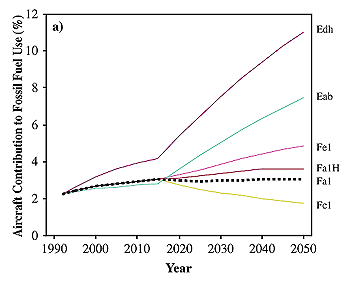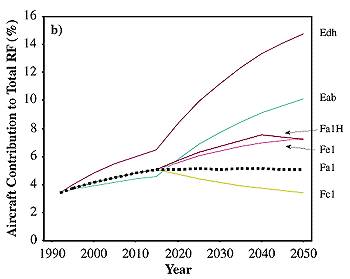|
6.6.3. Aircraft as a Fraction of Total Radiative Forcing
|


Figure 6-16: (a) Aviation fossil fuel use relative to
the
IS92a fossil fuel use from 1990 to 2050 for the air
traffic scenarios Fc1, Fa1, Fa1H, Fe1, Eab, and Edh;
and (b) from aviation as percentage of total radiative
forcing (without additional cirrus).
|
In the aircraft scenarios considered here, the relative amount of aviation
fuel burned in 1990 (2.4% of all fossil fuel carbon emissions) would increase
by 2050 to about 3% (Fa1) or more than 7% (Eab) depending on projections for
air traffic (see Figure 6-16a). For the other scenarios
here-with economic assumptions differing from the reference case IS92a, hence
a different demand for air transport-these fuel fractions in 2050 may be a factor
of 1.5 larger. In comparison, aviation was responsible in 1990 for about 3.5%
of total anthropogenic RF. This fraction would grow to about 5% in 2050 for
Fa1 and 10% for Eab. Figure 6-16b shows the evolution
of aviation RF from 1990 to 2050 for several scenarios as a percentage of total
IS92a RF. The climate change forced by aircraft, as measured by the summed RF,
is a larger proportion of total RF than indicated by fuel use alone. Thus, aviation
is an example of an industry for which the climate impacts of short-lived perturbations
such as O3 and aerosols/clouds must be considered when
evaluating the sector as a whole. This effect is also demonstrated by RFI-the
ratio of summed RF to CO2-RF-which
is greater than 1 (see Table 6-1).
Each of the demand scenarios has a technology 2 option in which a 25% reduction
in EI(NOx) (corresponding to a 22% reduction in total
NOx emissions) is achieved at an additional fuel cost
of about 3.5%. These options are calculated to have very little impact on total
RF (Table 6-1) because the reduced O3-RF
is offset by the increased CH4-RF and the small extra
fuel burn CO2-RF). If the CH4
perturbation is tied to the O3 perturbation as the models
now indicate, then the O3-RF and the CH4-RF
nearly cancel, and efforts at NOx reduction may not be
as effective in reducing RF as previously estimated when only ozone changes
were considered. However, these opposing contributions to the radiative imbalance
are very non-uniform in geographic extent, and the regional climate response
may not simply disappear (see Section 6.5.1). Moreover,
the prospect of large and canceling RFs, each with large independent uncertainties,
greatly increases the probability of a large residual.
6.6.4. The HSCT Option and Radiative Forcing
The HSCT option of building a fleet beginning in 2015 and capping at 1,000
aircraft in 2040 (scenario Fa1H) has significant impact on total aviation RF,
as shown in Figure 6-15c. The addition of HSCT
aircraft (+0.08 W m-2) increases RF for scenario Fa1
by a factor of 1.4, becoming comparable to RF for the higher demand scenario
Fe1 (see also Figure 6-16b). The HSCT aircraft
themselves cause RF of +0.10 W m-2, which is offset only
by -0.02 W m-2 from displaced subsonic aircraft. This
large RF from HSCT aircraft is driven mainly by RF from increased stratospheric
H2O. This single component has a large uncertainty (at
least a factor of 3) associated with the calculation of the stratospheric buildup
of water and the value of RF. The differential CO2-RF
penalty for HSCT aircraft is only 3% of total aviation RF. In conclusion, the
best estimate of RF from HSCTs is about five times as large as RF from the subsonic
fleet they replace; however, with the large confidence intervals on O3
and H2O, this factor has a very large uncertainty and
may range from 0 to 16.
|